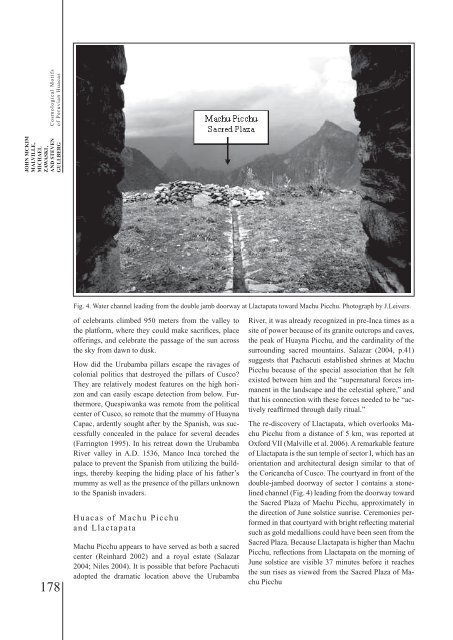BALTICA10
BALTICA10
BALTICA10
Create successful ePaper yourself
Turn your PDF publications into a flip-book with our unique Google optimized e-Paper software.
JOHN MCKIM<br />
MALVILLE,<br />
MICHAEL<br />
ZAWASKI ,<br />
AND STEVEN<br />
GULLBERG<br />
Cosmological Motifs<br />
of Peruvian Huacas<br />
Fig. 4. Water channel leading from the double jamb doorway at Llactapata toward Machu Picchu. Photograph by J.Leivers.<br />
178<br />
of celebrants climbed 950 meters from the valley to<br />
the platform, where they could make sacrifices, place<br />
offerings, and celebrate the passage of the sun across<br />
the sky from dawn to dusk.<br />
How did the Urubamba pillars escape the ravages of<br />
colonial politics that destroyed the pillars of Cusco?<br />
They are relatively modest features on the high horizon<br />
and can easily escape detection from below. Furthermore,<br />
Quespiwanka was remote from the political<br />
center of Cusco, so remote that the mummy of Huayna<br />
Capac, ardently sought after by the Spanish, was successfully<br />
concealed in the palace for several decades<br />
(Farrington 1995). In his retreat down the Urubamba<br />
River valley in A.D. 1536, Manco Inca torched the<br />
palace to prevent the Spanish from utilizing the buildings,<br />
thereby keeping the hiding place of his father’s<br />
mummy as well as the presence of the pillars unknown<br />
to the Spanish invaders.<br />
Huacas of Machu Picchu<br />
and Llactapata<br />
Machu Picchu appears to have served as both a sacred<br />
center (Reinhard 2002) and a royal estate (Salazar<br />
2004; Niles 2004). It is possible that before Pachacuti<br />
adopted the dramatic location above the Urubamba<br />
River, it was already recognized in pre-Inca times as a<br />
site of power because of its granite outcrops and caves,<br />
the peak of Huayna Picchu, and the cardinality of the<br />
surrounding sacred mountains. Salazar (2004, p.41)<br />
suggests that Pachacuti established shrines at Machu<br />
Picchu because of the special association that he felt<br />
existed between him and the “supernatural forces immanent<br />
in the landscape and the celestial sphere,” and<br />
that his connection with these forces needed to be “actively<br />
reaffirmed through daily ritual.”<br />
The re-discovery of Llactapata, which overlooks Machu<br />
Picchu from a distance of 5 km, was reported at<br />
Oxford VII (Malville et al. 2006). A remarkable feature<br />
of Llactapata is the sun temple of sector I, which has an<br />
orientation and architectural design similar to that of<br />
the Coricancha of Cusco. The courtyard in front of the<br />
double-jambed doorway of sector I contains a stonelined<br />
channel (Fig. 4) leading from the doorway toward<br />
the Sacred Plaza of Machu Picchu, approximately in<br />
the direction of June solstice sunrise. Ceremonies performed<br />
in that courtyard with bright reflecting material<br />
such as gold medallions could have been seen from the<br />
Sacred Plaza. Because Llactapata is higher than Machu<br />
Picchu, reflections from Llactapata on the morning of<br />
June solstice are visible 37 minutes before it reaches<br />
the sun rises as viewed from the Sacred Plaza of Machu<br />
Picchu
















